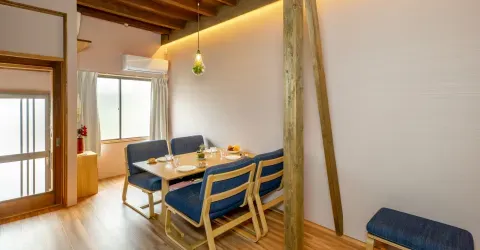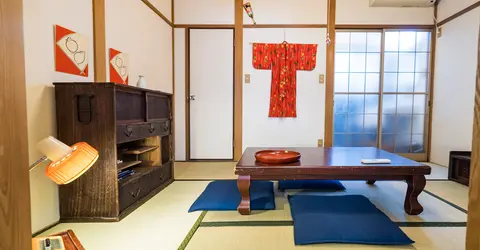Teramachi Walk I
- Teramachi History
- Kanga'an
- Jozenji
- Tenneiji
- Saionji
- Kami Goryo Shrine
- Amidaji
- Junenji
- Butsudaji
- Shokokuji
- Accommodation along Teramachi
- Teramachi Access
- Teramachi Map
Teramachi, Kyoto 寺町
This self-guided walking tour of Teramachi in Kyoto is based on Judith Clancy's excellent book Exploring Kyoto: On Foot in the Ancient Capital.
Part of the fun of following her words is the joy of recognition as you find the many historic Buddhist statues, graves and trees the author points out along the way.
This walk is off-the-beaten-track Kyoto and may not appeal to those wishing to "do" the major temples in Kyoto on a short, first visit. It should appeal to those visitors who have already seen the "sights" and wish to explore a little deeper into a quieter, less crowded, neighborhood Kyoto.
The map in Clancy's book is adequate but you may wish to supplement it with the Google map at the bottom of this page.

Tenneiji Temple with Mt. Hiei framed in the entrance gate, Teramachi, Kyoto
The walk starts from Kuramaguchi Station on the Karasuma Line of the Kyoto subway and finishes on Shijo Dori in downtown Kyoto's main shopping area near Nishiki Market.
In all, the walk takes the best part of the day, around six hours. You may well want to divide it into two half-day walks or choose just one half.
The northern half from Kuramaguchi to Marutamachi is mainly rather unvisited, historic temples and shrines, where it would be rare to encounter many other tourists except at Shokokuji Temple. This part can also be covered by hire cycle, whereas cycling is not possible in the shopping arcades in the southern half.
The southern half of the walk south from Imadegawa to Shijo includes the popular shopping arcades (shotengai) of Teramachi and Shinkyogoku, thronged with tourists and local shoppers enjoying the many specialist shops, selling unique and expensive, traditional Kyoto arts and crafts, souvenir stores hawking cheap tat and a variety of restaurants from 400 year-old Edo Period eateries to McDonalds and Starbucks.

Jishoin Temple, a sub-temple of Shokokuji, Kyoto

Jishoin Temple, a sub-temple of Shokokuji, Kyoto
Teramachi History
The history of Teramachi ("Temple District") really begins with the warlord Toyotomi Hideyoshi who reorganized the streets in Kyoto and moved many of the city's temples to Teramachi, Shimo Teramachi and Teranouchi.
On the whole, the temples on Teramachi are located on the eastern side of the street, or on your left, as you walk north to south.
After the relocation of the capital from Kyoto to Tokyo in 1868, and the Meiji government's initial prejudice against Buddhism, which was seen as a "foreign" influence, many of the temples on the walk lost some of their prestige and importance. Judith Clancy describes them as "modest" - which with the exception of Shokokuji they are. This also means that the majority of them are free to enter.
Mt.Hiei is a landmark to your left (east) as you walk down Teramachi and like all places in Japan, Teramachi is probably best strolled during the cherry blossom in spring or autumn leaf viewing season in the fall.
Some of the temples on the walk use Mt. Hiei as borrowed scenery in their gardens.

Kangaan Temple, Chinese-style gate, Kyoto

Kangaan Temple, statues of Chinese sages, Kyoto
Kanga'an 閑臥庵
To reach Kanga'an turn right out of Exit 1 at Kuramaguchi Station and take a right at the first set of traffic lights. After a few hundred meters you will see the white, Chinese-style entrance gate.
Kanga'an (Tel: 075 256 2480; kangaan.jp) is now part temple, part-restaurant. The temple belongs to the Otaku school of Zen Buddhism. The approach to the temple includes modern statues of Chinese sages on your right. The temple offers a variety of Japanese cuisine known as fucha ryori - deep-fried dishes served on trays in a tatami room with views of the garden. Reservations are necessary.

Jozenji Temple, Teramachi, Kyoto
Jozenji 上善寺
Jozenji is the next temple on Kurama-guchi dori on your left. Jozenji is a Jodo-shu sect temple that was much larger and important in the Edo Period, once having 10 sub-temples.
Now much reduced, the temple is famous for a wooden statue of Jizo supposedly carved by the Heian era courtier Ono no Takamura, after he had died. The image is on view only from August 22-23.

Tenneiji Temple grounds, Teramachi, Kyoto
Tenneiji 天寧寺
Turn right at the Kurama-yu public bath (sento) on to Teramachi and immediately on your left is Tenneiji (Tel: 075 231 5627), a Soto Zen temple, known for its main entrance gate framing a perfect vista of Mt. Hiei in a supreme example of borrowed scenery. Tenneiji contains the grave of Sowa Kanamori, an Edo Period tea master. The temple was relocated from Aizu Castle in Fukushima Prefecture.

Saionji Temple entrance gate, Teramachi, Kyoto
Saionji 西園寺
The next temple is Saionji just a few meters south on your left. Saionji was originally founded in 1224 in the north west of Kyoto and moved here under Hideyoshi's reforms. The main hall dates from 1788, rebuilt after the devastating Temmei Fire of the same year. The temple has some associations with the Meiji, Taisho and Showa era politician Kinmochi Saionji (1849-1940).

Kami Goryo Shrine, Teramachi, Kyoto
Kami Goryo Shrine 上御霊神社
Now turn right down Kami Goryo-mae Dori to get to Kami Goryo Shrine. Kami Goryo Shrine was established during the Heian Period of Japanese history on the site of a former Buddhist temple and the shrine nowadays has much of the look of a Buddhist temple rather than a Shinto shrine. Goryo Shrine was reputedly founded on the orders of the Emperor Kammu (737-806) after Kyoto became the imperial capital in 794.
Kami Goryo Shrine is a guardian shrine of the Imperial Palace of Kyoto and prayers have been said here for centuries to placate evil spirits that may threaten the city. Goryo Shrine is thought to be the site of the start of the Onin War (1467-1477) which ravaged much of Kyoto during the Muromachi Period. Over a century was to pass before the warlord Toyotomi Hideyoshi rebuilt and restored the shrine.
Goryo Shrine hosts a small flea market on the 18th of each month. Goryo's main festival is held on May 18 with parades around the local streets with participants in period costumes carrying the shrine's mikoshi. Walk back the way you have come along Kami Goryo-mae Dori to Teramachi and turn right at a Doshisha University dormitory to get to the next temple, Amidaji. Amidaji, Junenji and Butsudaji are in a row on your left as you walk south down Teramachi.

Stone lantern next to the presumed grave of warlord Oda Nobunaga, Amidaji, Teramachi, Kyoto
Amidaji 阿弥陀寺
Amidaji Temple is known as the temple containing the grave of the warlord Oda Nobunaga, who was killed or committed ritual suicide at Honnoji Temple, now located further south on Teramachi, after an attack by his erstwhile retainer Akechi Mitsuhide. Walk to the left of the main hall in to the cemetery to find his grave, which is sign posted and located next to a large stone lantern.

Junenji Temple, Teramachi, Kyoto
Junenji 十念寺
Next door to Amadaji, Junenji Temple is a Jodo-sect temple with a modern design dating from 1993 built by a priest/architect from the equally modern Isshinji Temple in Tennoji, Osaka.
Junenji contains the grave of Yoshinori Ashikaga (1394-1441) the sixth shogun of the Ashikaga shogunate.

Butsudaji Temple cemetery, Teramachi, Kyoto
Butsudaji 佛陀寺
Butsudaji, a few meters south of Jenenji on Teramachi, is a Jodo-shu sect temple moved here from near the Imperial Palace, where it once enjoyed imperial favor under the Emperor Suzaku (923-952).
Destroyed in the devastating Onin War (1467-1477) which ruined so much of medieval Kyoto, the temple was finally located by Hideyoshi to its present location. The main object of worship is a Kamakura Period statue of Amida.

Shokokuji Temple, Kyoto
Shokokuji 相国寺
Shokokuji Temple is a large temple complex to the west here (to your right) off Teramachi. Walk along Kamitachiuri Dori to get to the entrance. Shokokuji is the second of the five leading Rinzai Zen temples in Kyoto that were built during the medieval Muromachi Period. Shokokuji once housed a collection of well-known panel paintings, which now can be seen at the Jotenkaku Museum on the grounds that opened in 1984.
Sub-temples of Shokokuji include Daikomyoji and Jishoin. East of the temple is a graveyard dedicated to warriors of the Satsuma domain (Kagoshima Prefecture) killed during the struggle to overthrow the Tokugawa regime in the 1860's. It is located next to Kyogoku kindergarten.

Stone pillar marking Sainokami Shrine, Teramachi, Kyoto
Back on Teramachi, walk south past the Nichiren Hommanji Temple and a stone pillar marking Sainokami Shrine.
Further south to your left is the lively Demachi Masugata arcade (shotengai) leading east to Demachiyanagi Station, with lots of local fruit and vegetable shops, cafes and a supermarket.
When you arrive at the junction with Imadegawa-Teramachi and another stone marker, called Oharaguchi Guidepost (Oharaguchi Dohyo), demarcating the north-east corner of the Heian-kyo capital, this is the end of the first part of the Teramachi walk. The junction, called Oharaguchi, was an important intersection in Edo-era Kyoto. Going north from here took you up Demachi Street to Ohara, and further on to the province of Wakasa (now part of Fukui Prefecture). South and west of here was the city of Kyoto. This stone is recorded as having been erected by people from the vicinity in 1868, along with another 22 such markers north, south, east and west of it, each indicating a destination and the distance. Formed from good quality granite, and marked with well-formed characters, this is one of the best preserved marker stones in Japan. It is therefore a registered cultural property of Kyoto City, along with similar markers at Sanjo Shirakawa Bridge, Gojo-wakare, Yoshida-honmachi, and Kitashirakawa Nishimachi.
Accommodation along Teramachi
This area of Kyoto does not have an over-abundance of hotels but there are a number of holiday home lets such as Kyoto Jyusei An near Kuramaguchi Station and Muromachian. Nashinoki Inn is a small family-run accommodation offering breakfast and free-use bicycles to the west of Demachiyanagi Station at the southern end of the walk.

Kuramaguchi subway station, Karasuma Line, Kyoto
Access: Getting To Teramachi
From Kyoto Station take a Karasuma Line train on the Kyoto subway to Kuramaguchi Station.
Take Kyoto city bus #37 from Shijo Kawaramachi Station bound for Kitaoji Bus Terminal to the Izumo jibashi bus stop.
Teramachi Map
Kyoto Related Articles
Books on Japan Nature
Teramachi is an historic street in Kyoto, lined with historic temples and shrines, that runs from Kuramaguchi in the north to south of Shijo in the downtown area.






























